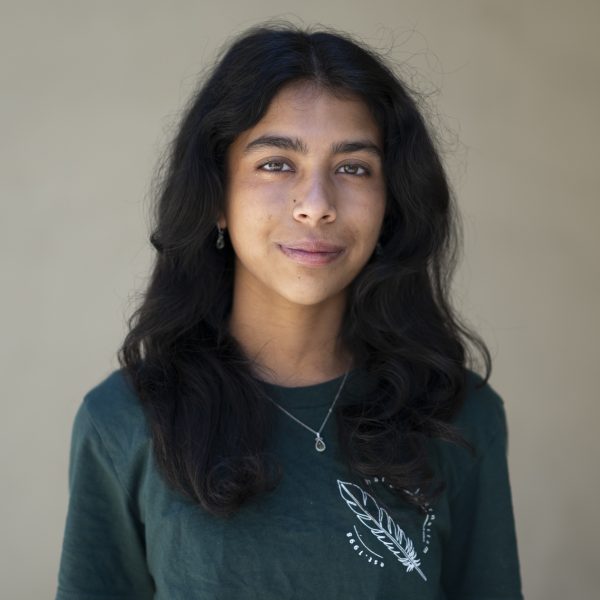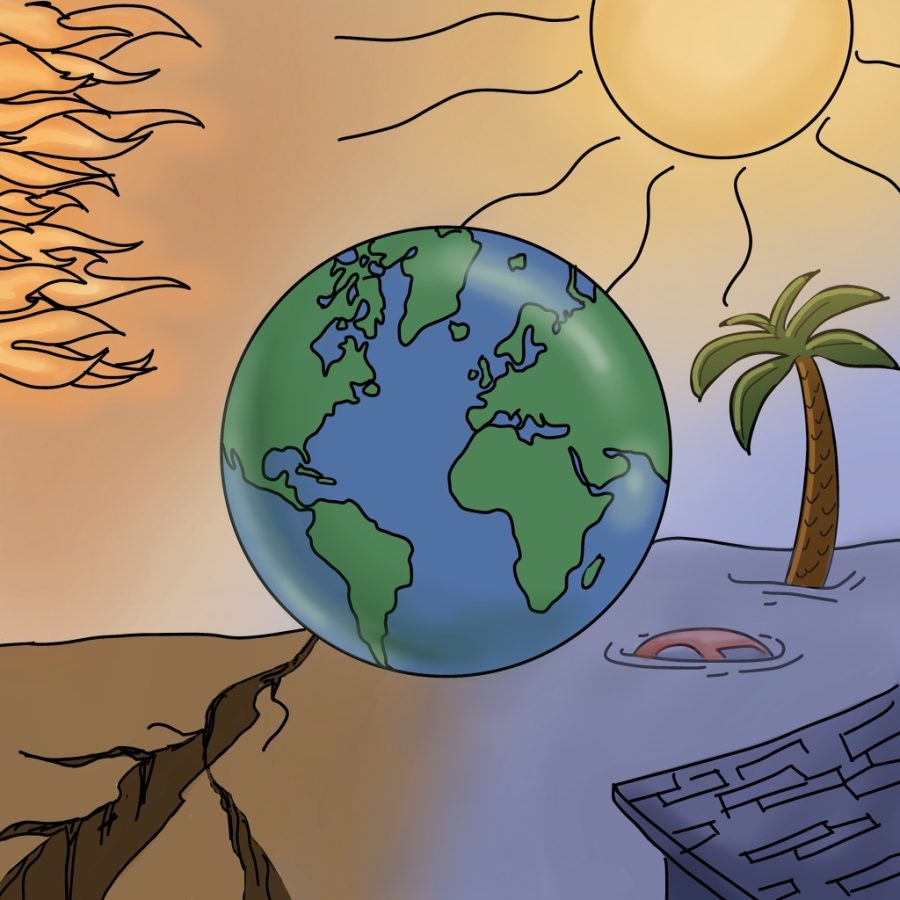Cloudy or clear: Our climate future rests in our hands
Climate change triggers extreme weather around the globe
Instances of extreme weather are rising, along with their impacts, placing increased populations at risk from climate hazards. The number of weather-related disasters has increased by a factor of five over the past 50 years, with human activity at the vanguard of causes.
Scorching temperatures and raging wildfires in California. Severe droughts in the U.S. and Europe. Catastrophic flooding in Pakistan and Italy. Devastating hurricanes across the world.
Instances of extreme weather are rising, along with their impacts, placing increased populations at risk from climate hazards. The number of weather-related disasters has increased by a factor of five over the past 50 years, with human activity at the vanguard of causes.
“We’re learning and we’re taking preventative measures — the issue is, is it enough?” wildfire AI project leader Rohan Bhowmik (12) said. “Will we continue to do this? Will we forget our mistakes in the future? And will we fall victim to the same problems we have in the past?”
As of 2022, carbon dioxide levels have increased by over 50% since the Industrial Revolution. Carbon dioxide, a greenhouse gas, creates a blanket around the planet, trapping heat in the atmosphere, according to upper school environmental science teacher Jeff Sutton. Other greenhouse gases include methane and nitrous oxide.
“Climate change, the change in ocean temperature, or wind speed, [is] caused by the amount of CO2 and the amount of energy,” Sutton said. “That’s what CO2 traps — that energy. So now, we have our earth systems being moved towards a different amount of energy that’s available, which is more, [and] you get more weather extremes from day to day.”
Although global warming influences extreme fluctuations in weather, Sutton emphasizes the difference between weather, climate and climate change. While weather is daily temperature, climate is the long-term patterns and fluctuations in weather.
Climate change affects weather through high-pressure and low-pressure cells, according to Sutton. High-pressure cells exist in areas that have a higher pressure at the center compared to the surroundings and are commonly associated with hotter, drier weather. Conversely, low-pressure systems house lower pressures at their centers and produce storms, hurricanes and other wet weather.
In high-pressure systems, denser cold air entering the area warms up rapidly, creating a zone of high pressure air, which is unyielding to other weather trying to move into the area. The situation causes inflated temperatures in regions, such as the record-breaking California heat wave during the first week of September. California temperatures surged to unprecedented numbers with highs such as 109 degrees Fahrenheit on Sept. 6 in San Jose.
Heat waves drastically impact the environment and those inhabiting it. For example, during the week of the heat wave, the upper school canceled multiple outdoor sports games and cautioned students to drink water and stay inside. Large areas of California also experienced power outages and received warnings to limit energy usage. For many animals, these high temperatures can disable their thermoregulation, and similar anomalies also occur in the botanical world.
“All my trees are starting to lose their leaves early this year, and they’re not brown — they’re green,” Sutton said. “That’s from the heat last week, so in order to try to conserve water and conserve energy, a lot of organisms will change their behavior.”
Green Team member Sophie Grace (10) adds that extreme weather patterns can harm the health of entire communities.
“Coral reefs are dying — a lot of ecosystems are dying because they can’t deal with the heat,” Sophie Grace said.
Although blackouts loosen the strain on the electrical grid, energy consumption still skyrockets during heat waves. 61% of electrical power originates from fossil fuel power plants, which release carbon dioxide into the air, worsening climate change. Since climate change is also the primary cause of heat waves, the process creates a yet to be broken feedback loop.
The loop’s impacts extend past increased electrical use and emissions as heat waves also increase the risk of wildfires. Between Sept. 4 and Sept. 8, 13 fires began in California, and amongst these fires were the Southern Californian Fairview fire, which burned 37 square miles, and the Mosquito Fire in the Sierra that forced 2,500 people to evacuate. According to the First Street Foundation, one in six Americans face wildfire risks.
In addition to ending lives and destroying buildings or even entire towns, wildfires also cause air pollution, which is especially dangerous for young children, the elderly, people with chronic health conditions and people recovering from COVID-19. So far in 2022, wildfires have burned 360,000 acres of land and killed nine civilians.
In last year’s Synopsys competition, an annual student science championship, Rohan created an AI program to calculate the risk of wildfire in an area based on environmental factors such as temperature, wind speed and vegetation health. He notes that although California is home to historically major wildfires, their impacts have increased in recent years.
“They are exaggerated by two things: one is the density of humans within the state of California has dramatically increased,” Rohan said. “But the other reason is we don’t like things burned. If you don’t let trees burn, you get a lot of trees that are ready to burn in a very dense area. It’s just tinder waiting to be sparked.”
One possible solution to this issue is prescribed burning, which refers to purposefully starting a controlled fire in a specific area of forest. Dried branches, dead trees and other built up organic material are burned, eliminating fuel sources for future wildfires. However, unlike wildfires, prescribed burns are carefully monitored and prevented from spreading out of control or to human settlements. Prescribed burns were initially practiced by indigenous communities, but governments have also begun taking interest. For example, in March this year, California issued plans to implement prescribed burns on 400,000 acres of land each year.
Although authorities are taking steps in the right direction, these measures will take time to be effective. In the meantime, Rohan advises people on how to stay safe from wildfires.
“Check the news on the wildfire every one hour,” Rohan said. “Why? Because if that fire goes into your neighborhood, you need to prepare for evacuation. Most people will just need to look out for smoke for pollution. That’s where staying indoors matters, preventing yourself from being exposed to toxic chemicals, toxic gasses. If you can’t, wear a mask at least.”
Aside from wildfires, heat waves also increase the risk of droughts in areas such as California, which experienced an eight-year drought ending in 2019, the longest spanning one in the state’s history. Globally, drought conditions are ranked on a scale of increasing severity from abnormally dry, moderate drought, severe drought, extreme drought and exceptional drought, and 100%, 99.8%, 94.1%, 40.9% and 16.6%, of California’s land falls under the respective categories. This year broke records as California’s driest yet, according to the National Integrated Drought Information System (NIDIS), with the National Weather Service recently disseminating drought warnings to Los Angeles and Hartford. Like heat waves, droughts generate a 50% increase in highly destructive wildfires as detailed in a 2022 U.N. report.
“In the earlier years, California’s drought was a big issue [which] was a precursor to all the wildfires we have,” Rohan said. “California is drying up, which is making things ready to burn at an instant.
Drought, fueled by a lack of precipitation and multiple heatwaves, is also striking Europe. As of early August, 47% of Europe received drought warning conditions, and 17% was in drought alert conditions. The heatwaves and lack of water has led to a 16% decrease in maize production and a 15% decrease in soybean production, according to the European Drought Observatory.
While climate change exacerbates heat and fires in some areas of the world, it intensifies floods in others. Floods in Pakistan, which began in June 2022, have submerged one third of the country, damaged 1.8 million houses, destroyed 70% of crops and killed 1,580 people.
In Jackson, Mississippi, heavy rains caused a sharp drop in water treatment plants’ pressure. In addition to flooded streets, the low water pressure created the risk of untreated groundwater entering the pipes, and for seven weeks, Jackson’s residents were unable to drink tap water without first boiling it. Flash floods in September left Italy in similar conditions with over 1300 residents unable to find drinking water. After the hazard, officials found 10 dead, four missing and over 50 injured. In an unprecedented season of extreme weather, California, too, may be at risk of floods due to increased chances of precipitation following the weeks of the heat wave.
Since human activity primarily drives these severe weather conditions, Sophie Grace believes that our climate’s future rests in our hands. She recommends that people reform their everyday activities to lessen the effect of climate change.
“Since it is due to global warming, [people] could do the basic things like trying to use less energy,” Sophie Grace said. “Mostly typical things like solar energy and trying to not use as much water and not driving a lot. Just whatever you can do to lessen pollution.”
Both Sutton and Rohan also believe that a pervasive solution rests in human hands and the actions that we take. Meanwhile, Sutton advocates for the importance of optimism and education in combating climate change even when the future seems bleak.
“If you don’t know anything about [climate change], and you hear the news, people undergo a thing called learned helplessness where they just totally feel defeated,” Sutton said. “They think there’s nothing they can do, so why bother? [But] knowing what the systems are, what’s happening, and knowing that there are things you can do to alter the outcome — that’s pretty powerful.”

Kinnera Mulam (12) is the co-editor-in-chief of the Winged Post, and this is her fourth year on staff. This year, Kinnera hopes to get to know all the...

-Lindsey Tuckey (11) is the co-conservatory editor for the TALON Yearbook, and this is her third year on staff. This year, she hopes to explore people's...

Shareen Chahal (12) is a co-managing editor for the Winged Post, and this is her third year on staff. This year, Shareen hopes to extend her coverage to...


















![“[Building nerf blasters] became this outlet of creativity for me that hasn't been matched by anything else. The process [of] making a build complete to your desire is such a painstakingly difficult process, but I've had to learn from [the skills needed from] soldering to proper painting. There's so many different options for everything, if you think about it, it exists. The best part is [that] if it doesn't exist, you can build it yourself," Ishaan Parate said.](https://harkeraquila.com/wp-content/uploads/2022/08/DSC_8149-900x604.jpg)




![“When I came into high school, I was ready to be a follower. But DECA was a game changer for me. It helped me overcome my fear of public speaking, and it's played such a major role in who I've become today. To be able to successfully lead a chapter of 150 students, an officer team and be one of the upperclassmen I once really admired is something I'm [really] proud of,” Anvitha Tummala ('21) said.](https://harkeraquila.com/wp-content/uploads/2021/07/Screen-Shot-2021-07-25-at-9.50.05-AM-900x594.png)







![“I think getting up in the morning and having a sense of purpose [is exciting]. I think without a certain amount of drive, life is kind of obsolete and mundane, and I think having that every single day is what makes each day unique and kind of makes life exciting,” Neymika Jain (12) said.](https://harkeraquila.com/wp-content/uploads/2017/06/Screen-Shot-2017-06-03-at-4.54.16-PM.png)








![“My slogan is ‘slow feet, don’t eat, and I’m hungry.’ You need to run fast to get where you are–you aren't going to get those championships if you aren't fast,” Angel Cervantes (12) said. “I want to do well in school on my tests and in track and win championships for my team. I live by that, [and] I can do that anywhere: in the classroom or on the field.”](https://harkeraquila.com/wp-content/uploads/2018/06/DSC5146-900x601.jpg)
![“[Volleyball has] taught me how to fall correctly, and another thing it taught is that you don’t have to be the best at something to be good at it. If you just hit the ball in a smart way, then it still scores points and you’re good at it. You could be a background player and still make a much bigger impact on the team than you would think,” Anya Gert (’20) said.](https://harkeraquila.com/wp-content/uploads/2020/06/AnnaGert_JinTuan_HoHPhotoEdited-600x900.jpeg)

![“I'm not nearly there yet, but [my confidence has] definitely been getting better since I was pretty shy and timid coming into Harker my freshman year. I know that there's a lot of people that are really confident in what they do, and I really admire them. Everyone's so driven and that has really pushed me to kind of try to find my own place in high school and be more confident,” Alyssa Huang (’20) said.](https://harkeraquila.com/wp-content/uploads/2020/06/AlyssaHuang_EmilyChen_HoHPhoto-900x749.jpeg)



